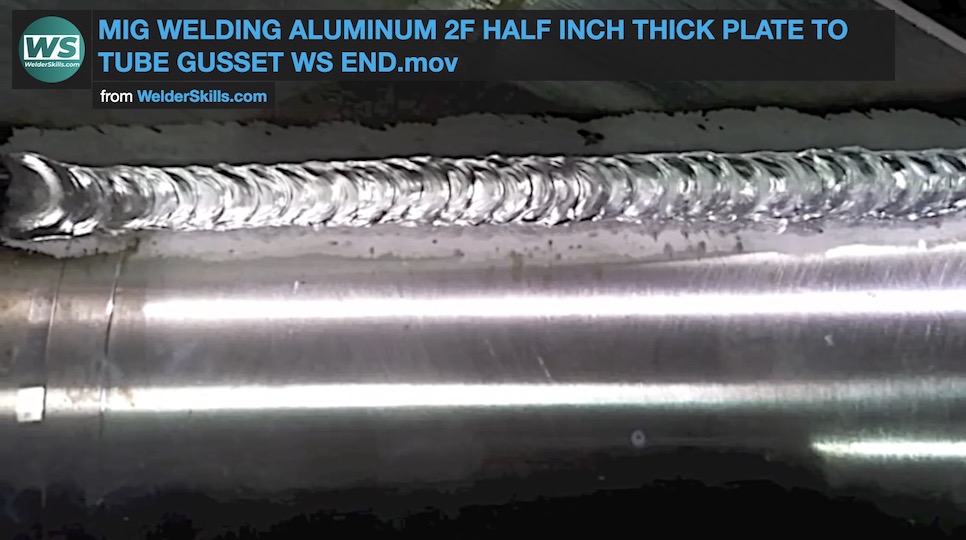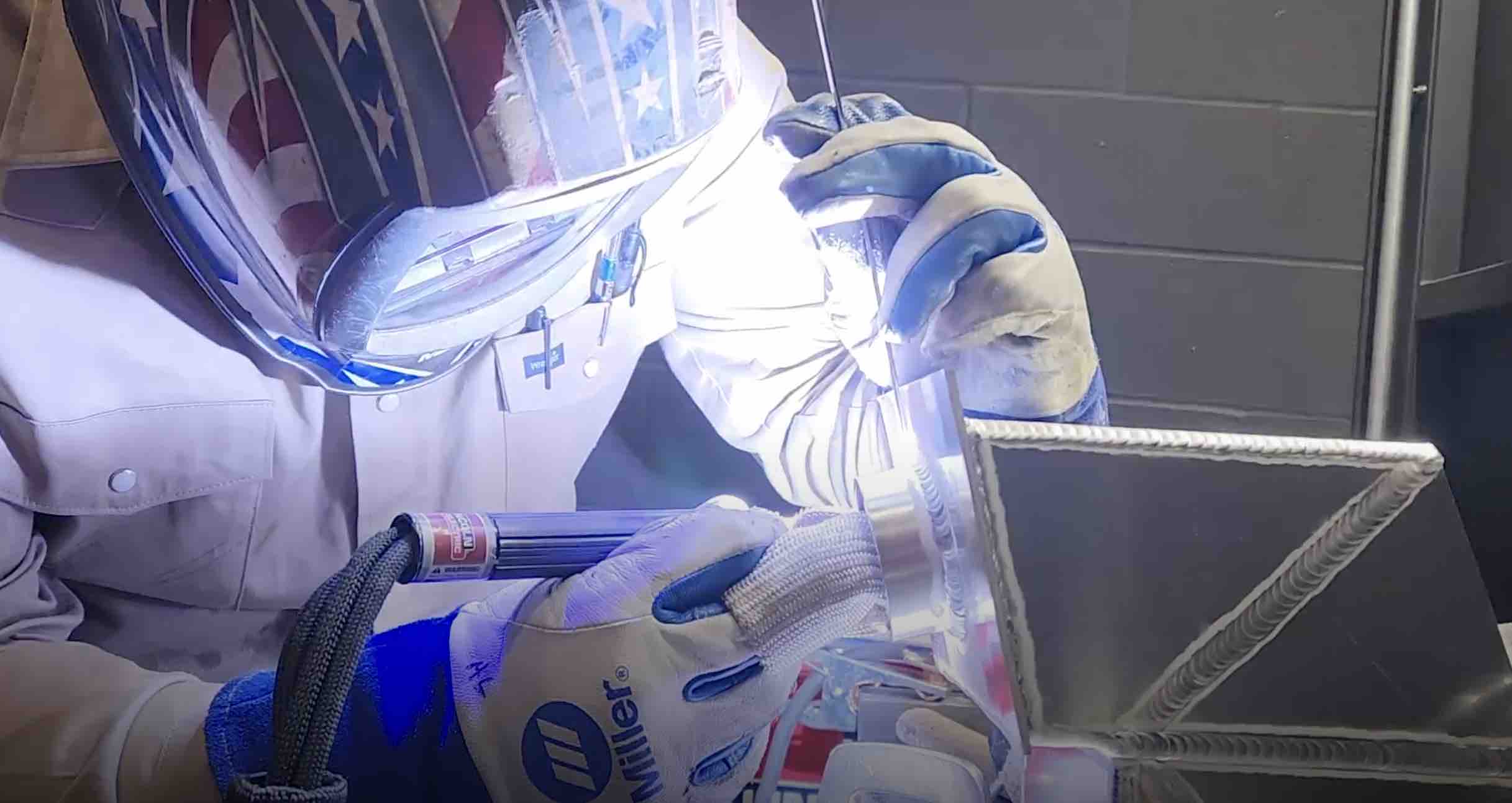How to Weld Aluminum
MIG Welding Aluminum with a spool gun
This page is about how to weld aluminum&MIG Welding aluminum with a Spool Gun
MIG welding Aluminum vs TIG
Did you know?..
There are over 800 videos over at welderskills.com from beginner stick welding to advanced TIG... to down and dirty repair videos on farm equipment...to 6G Pipe certification test videos.
Whether you are a student working on passing a welding test, hobbyist, or a working welder who wants to sharpen up, I want to encourage you to take the free 7 day test drive and get access to all the courses and over 800 videos.
Get in there and lets all get better together.
Its easy to sign up…and even easier to cancel with no hoops to jump thru.
Invest in yourself,
See you in there.
Jody
MIG welding aluminum with a spool gun is slightly more difficult than mig welding steel.
What makes it slightly more difficult is that all the little variables like stickout, gun angle, wire speed settings, and gas flow rates are much more sensitive....
Every variable seems to make way more difference with a spool gun.
So lets take a look at each of these variables and how we can dial them in for better results
- Wire speed
- gun angle
- stick out
- gas flow rate
Wire speed settings for mig welding aluminum with a spool gun
I have used quite a few different brand spool guns and some of them were prone to melt wire back to the tip if wire speed was even a little bit too low.
Rather than going thru a lot of tips when dialing in wire speed, I suggest starting off with a wire speed that is too high and weld on a piece of scrap aluminum.
Gradually dial back the wire speed until you get a smooth hum without much crackle sound or sparks.
too much wire speed results in shooters and sparks
too little wire speed results in wire burning back to the tip.
An occasional spark or shooter is way better than burning up a contact tip.
Gun Angle for mig welding aluminum
With mig welding steel, both pushing and pulling work. There are differences in penetration and spatter but both work well on steel.
For mig welding aluminum , a push angle is way better than a pull angle.
But sometimes there is no other way than to pull.
A pull angle will make for a lot of soot on the bead but usually this can be easily removed by wire brushing with a dedicated stainless wire brush.
A push angle lets the argon flow out in front of the puddle and allows for cleaning action of the arc to break up oxides.
But again, if your head is up inside an aluminum channel, and the only way to see the puddle is to pull, then pull and wire brush the soot after.
Stick out for mig welding aluminum with a spool gun
Stick out is the distance between the contact tip and the unmelted wire.
For mig welding steel using short circuit transfer, stickout should be short ...like 1/2" or less for best results.
MIG welding aluminum is spray transfer and needs a longer stick out of around 3/4"
Even when your voltage and wire speed are set right, if your stickout gets too close, you can see and hear a difference...usually in the form of sparks or a change in sound from the smooth spray hum to a crackle.
Instead of changing wire speed, sometimes your stickout needs to be longer.
Gas flow rate is more important than you might think
Argon is the most commonly used shielding gas for mig welding aluminum.
Flow rates for steel are very forgiving and have a very wide range.
Flow rates for mig welding aluminum are much tighter.
Not enough flow rate results in excess soot.
But too much flow rate results in a very erratic arc.
This seems to be related to the thermal conductivity of aluminum and the fact that you are blowing cold argon gas on the metal while you are trying to melt it.
To find out the flow rate limits, it helps to go ahead and weld a few beads with the flow rate too high and then reduce the argon flow until the arc smooths out.
I hope you enjoyed this video and page on How to Weld Aluminum&MIG Welding Aluminum with a spool gun
Most common mistakes MIG welding aluminum with a spool gun
When MIG welding aluminum with a spool gun, several common mistakes can affect the quality of the weld. Here are some of the most mistakes and how to avoid them:
1. Material Preparation
- Problem: Failing to clean the aluminum properly before welding can lead to contamination and poor weld quality.
- Solution: Clean the aluminum surface thoroughly using a stainless steel brush and acetone to remove oxides, dirt, and oil.
2. Improper Shielding Gas Selection
- Problem: Using the wrong type of shielding gas will cause all sorts of issues like soot, porosity, and frustration.
- Solution: Use pure argon gas for MIG welding aluminum. Argon provides good arc stability and penetration necessary for aluminum welding.
There are few alternatives like stargon AL or helium argon mixes but start with argon.
3. Incorrect Wire Feed Speed and Voltage Settings
- Problem: Incorrect wire feed speed and voltage settings can cause issues like burn back to the contact tip, burn thru of thin metal, or lack of fusion.
- Solution: Adjust the wire feed speed and voltage settings according to the thickness of the aluminum being welded. Refer to the welding machine’s manual or chart for recommended settings and fine tune to achieve a smooth humming sound.
4. Improper Technique
- Problem: Incorrect torch angle and travel speed can lead to poor weld quality.
- Solution: Maintain a consistent torch angle of about 10-15 degrees and use a push technique (torch pushing away from the weld pool). Keep a steady travel speed .
5. Improper Heat Management
- Problem: Aluminum dissipates heat quickly, which can lead to cold starts and hot craters.
- Solution: Preheat thicker aluminum sections to around 200°F to help with cold starts ...maintain consistent heat during welding.
6. Using the Wrong Filler Wire
- Problem: Selecting an inappropriate filler wire can cause poor weld quality and lack of strength.
- Solution: Use filler wire specifically designed for the aluminum alloy you are welding, Consult an aluminum filler metal chart like this one
7. Incorrect Spool Gun Setup
- Problem: Improper setup of the spool gun can cause feeding issues and poor weld quality.
- Solution: Ensure that the spool gun is set up correctly with proper tension on the wire spool and clean, well-maintained liners and tips. Make sure the wire is feeding smoothly without kinks or snags.
8. Lack of Proper Ventilation
- Problem: Poor ventilation can lead to a buildup of fumes, which is hazardous to the welder’s health and can affect weld quality.
- Solution: Ensure adequate ventilation in the welding area to disperse fumes and provide a safe working environment.
By avoiding these common mistakes and adhering to best practices, you can improve the quality and reliability of your MIG welds on aluminum using a spool gun.

















